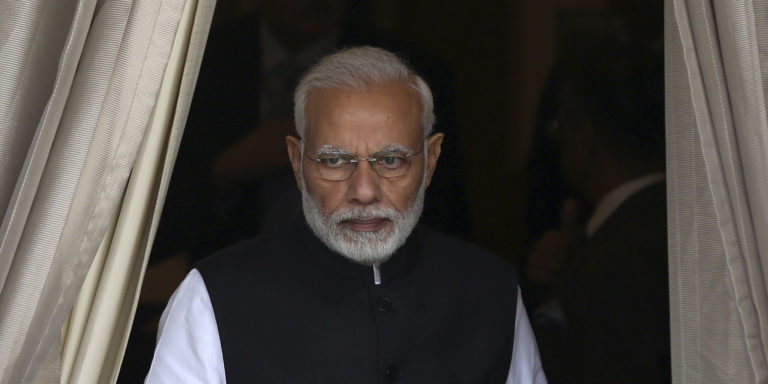INTELBRIEF
February 1, 2021
IntelBrief: India Faces Challenges on the Domestic and International Front in 2021

Bottom Line Up Front
- India is facing domestic challenges related to COVID-19 while also increasingly concerned about growing Chinese regional aggression.
- Calls for the U.S. to forge a strategic alliance with India are premised on views of New Delhi as bulwark against China and a natural democratic ally in the region.
- With private consumption falling and investments down dramatically, it could take India years to recover from the adverse impact of the pandemic.
- With India’s seat at the UN Security Council for the next two years, New Delhi will have an opportunity to further develop its relationship with China.
As the world emerges from the year 2020 ravaged by COVID-19, the prolonged recovery will cast a long shadow for many countries throughout the new year. This is particularly true for India, as it will continue to face the enormous challenge of managing the pandemic that has severely impacted its most vulnerable communities. In addition, India must contend with another Himalayan challenge- both in terms of its magnitude and the geographic location- in the form of continued military tensions with China. These twin challenges could possibly be termed as perhaps the greatest security challenges India has faced since the 1971 war with Pakistan which resulted in the emergence of independent Bangladesh. There are indeed other equally salient challenges that warrant the government's attention. These include internal security threats in the form of terrorism, a long-running Maoist insurgency, and the unabated communal and sectarian unrest that threatens to tear apart the social fabric of the country. Though India hastened to upgrade its military hardware, the grim economic projection for overall GDP is bound to shrink the defense outlay in real terms and adversely impact its military modernization program. Reeling under the impact of the pandemic, India’s GDP contracted by more than 23% during the first quarter of last year and by an additional 7% in the second quarter of 2020. The precarious economic projection would definitely impact India’s ability to sustain a tough stance against China.
Calls for the United States to forge a deeper strategic alliance with India are premised on views of New Delhi as bulwark against China in Asia, and a natural democratic ally in the region. However, even if such an alliance were to be formed, it would be far cry from the Cold War U.S. alliances with Europe and Japan. The Trump presidency dealt a crippling blow to U.S. soft power and hegemonic status in the region. Meanwhile, China has increased its economic and military influence. European partners no longer perceive Washington as a wholly dependable ally. Moreover, there is a growing realization that ‘the Quad’ as a multinational alternative to China is still tentative. The adverse impact of the pandemic on Japan's economy combined with the exit of Shinzo Abe has toned down the euphoria around the Quad. India will look to rely on bilateral partnerships to deal with China, while also potentially exploring new multilateral partnerships that could be enhanced by its incoming role in the UN Security Council. The fait accompli presented by China in the Galwan Valley of Ladakh in early 2020 and subsequent developments once again brought to the fore the overall inadequacies in India’s defense preparedness, particularly in terms of its force projection capabilities and gaps in its military hardware. New Delhi recognized early on, as tensions began to rise, that there was little it could do to seriously challenge Chinese military might—the risk of further escalation was too great.
Beyond the costs in terms of human life, the devastating effects of the pandemic are now apparent in many sectors. Recent reports by the International Monetary Fund (IMF) on the World Economic Outlook estimates that over 40 million Indians may fall into extreme poverty due to the pandemic. It will be nearly impossible for any state to meet expectations of reverting to pre-COVID economic levels and social dynamics. With private consumption falling by 27% and investments down by 47%, economists estimate that it will take India ‘years’ to recover from the adverse impact of the pandemic. Such conditions could further fuel internal strife and exacerbate existing societal fault lines. The pandemic has already demonstrated how the virus was used to target vulnerable sections of society via social and economic boycotts.
There are growing domestic voices and pressure groups that want India to engage in a limited show of force if China will not revert to pre-April positions along the Line of Actual Control. The realistic escalatory potential of any such limited conflict would not only be disastrous but also prohibitively costly for both countries. For India, the overall policy landscape in 2021 will be shaped by its ability to resolve the ongoing border standoff with China without losing face, while also improving its capabilities to limit the economic and social disruption caused by the pandemic. With India’s seat at the UN Security Council for the next two years, New Delhi will have an opportunity to further develop its relationship with China, a relationship that will determine its scope for action, especially in areas of declared interest such as counterterrorism and sanctions policy. At the same time, there may be opportunities to use multilateral approaches to address regional tensions.